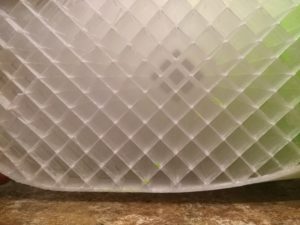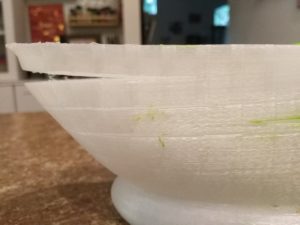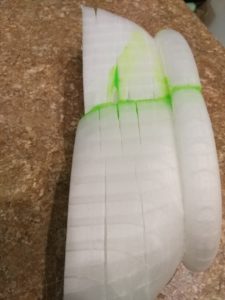The Ugly – When prints fail
We have been working on a custom designed sword project that I completed the model for yesterday. The handle has been printed already, so I started on the blade yesterday… a 20+ hour print. Lately, I have been prototyping with a cheap roll of ABS (More on that later) and I have had some fairly good results. I started the print around 10 AM yesterday and hoped to wake up to at least a nearly finished product this morning.
Instead, I was startled awake by a crack, a snap and then some dragging noises. Fearing the worst, I jumped out of bed at 5AM and ran to the print room. I thought the print had popped off the bed as sometimes ABS will contract while cooling and pop itself free. This time, it stayed on the bed, but had such crazy layer separation that the layers popped up and got snagged by the hot-end. Here are some fun photos to show you. Ignore the green… I wanted to test fit some stuff before committing to another print job.
So… why did it fail, you ask? What could have caused such crazy layer separation? It is a combination of things, actually. Let’s start with the plastic type used for the print. I used ABS plastic on this. ABS is awesome for getting intricate details and for it’s structural integrity. The plastic has a bit of a flex to it, so it can take an impact without shattering. Sounds awesome, right? ABS’s largest strength is also it’s largest downfall when it comes to 3D printing. With all of those properties, the plastic shrinks a bit when it is cooling, hence the finer detail. As the plastic is shrinking, if layers cool at a different rate from each other, warping and splitting can occur. This is fairly easy to combat though. If you build a chamber around your printer (even a box will work) you can mitigate this effect by shielding the print from ambient air. Now, let’s look at the quality of the plastic I used. This spool of plastic was $12 for a kilogram on Amazon! I know, right? I love how this plastic prints with small parts and actually printed a few hand-spinners with it. The downside is that it is very weak. I spilled some isopropyl rubbing alcohol on one of my hand-spinners and it just about exploded! The plastic became super brittle and disintegrated in my hands (photo below). I don’t know what was blended in with this to make it so cheap, but make sure for high quality prints, you use high quality plastics. Notice, I didn’t say expensive, make sure you try out many different brands and types of plastic. You never know when you will find a favorite cheap one!

The good news is that when I created this sword, I created it too thick and the dimensions don’t feel quite right to match the handle design. This failed print is allowing me to go back and redesign without losing 3 days of print time.



